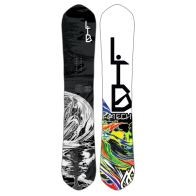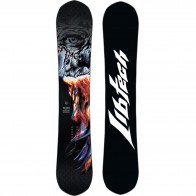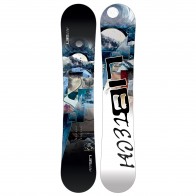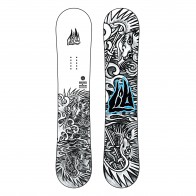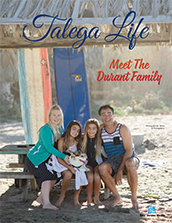Description
Details

OUTLINE
TAPERED UNDERBITE
Similar looking to “wings” or bumps on a surfboard, it functions a little different on snow. Each side the board’s effective edge is segmented into 3 distinct parts. Beginning at the nose, the sidecut is approx. 8 meters radius. At the front binding area, the edge steps inward by 2mm, the sidecut changes to approx. 7 meters and continues with that radius until the rear insert pack. Then, the edge steps in again 2mm and the sidecut tightens to approx. 6 meters. Traditional “tapered boards” take the full sidecut and pull the tail inward, which is away from the arc of your turn – this is why they tend to wash out under hard carving. The Tapered UnderBite corrects this by: 1) keeping the sidecut parallel to its corresponding one on the other side of the board. 2) Increasing the sidecut depth as you move towards the tail creating a corrective “hook” to the taper. The board blends into turns effortlessly, has the directional drive and float you’d expect from a tapered board, but it holds an edge and rockets out of turns like nothing else.

CORE
WEIGHTLESS
The weightless core strikes a critical balance between lightweight and strength. Using a lower density species of Poplar in areas that are not as structural and Paulownia in the areas that are, we’re able to shave precious weight off our beloved 420 and now the 20/20. This helps a board not only float, but “feel” floaty.
BASE PROFILE
DIRECTIONAL CAMROCK 1-4-2

BASE MATERIALS
SINTERED TRUE
Just like it says. Pellets or course powder is pressed until it forms a solid. There are several suppliers for our entire industry and they each have different codes for them, depending on the color and transparency. These codes can make it seem like you’re getting many different kinds and grades of sintered but they’re all pretty much the same as far as you and I will ever tell. True Sintered is harder and more expensive than extruded and it can be faster for those that ride aggressively fast. But to do that, it needs to be waxed and prepared for local conditions.
PYL SPECS
| Board Length (cm) | 156 | 159 | 160 W |
|---|---|---|---|
| Surface Area (dm2) | 40,7 | 41,9 | 43,9 |
| Tip Length (cm) | 33,5 | 34 | 34 |
| Tail Length (cm) | 21,5 | 22 | 22 |
| Effective Edge Length (cm) | 116 | 118 | 119 |
| Contact Length (cm) | 101 | 103 | 104 |
| Waist Width (cm) | 25 | 25,3 | 26 |
| Front Foot Width (cm) | 26 | 26,4 | 27,1 |
| Rear Foot Width (cm) | 25,8 | 26,2 | 27 |
| Tip Width (cm) | 30 | 30,3 | 31,1 |
| Tail Width (cm) | 29,4 | 29,8 | 30,6 |
| Taper (cm) | 0,5 | 0,6 | 0,6 |
| Rocker / Camber (mm) | R0.1-C0.4-R0.2 | R0.1-C0.4-R0.2 | R0.1-C0.4-R0.2 |
| Sidecut Radius (m) | 7.6 - 6.7 - 5.8 | 7.8 - 6.9 - 6 | 7.8 - 6.9 - 6 |
| Ref. Point (cm) | 54,6 | 57,2 | 58,4 |
| Ref. Point (in) | 21,5 | 22,5 | 23 |
| Ref. Stance Setback (cm) | 1 | 1 | 1 |
| Min Ref. Stance Width (cm) | 48,6 | 51,2 | 52,4 |
| Min Ref. Stance Width (in) | 19,1 | 20,1 | 20,6 |
| Max Ref. Stance Width (cm) | 60,6 | 63,2 | 64,4 |
| Max Ref. Stance Width (in) | 23,9 | 24,9 | 25,4 |
| Rider Weight (lbs) | 130-180 | 140-190 | 160-210 |
| Rider Weight (kg) | 59-82 | 63-86 | 72-95 |
Reviews
- Say Yes to YESReview by Andrew
- The staff at SoCal is amazing. They provided me a lot of help and info on this board before purchase. This board is AMAZING! Perfectly shaped and wide for my style of riding. If you're 6'3" I suggest you check out YES boards. Love my Burton but YES is solid! (Posted on 11/5/23)
- Favorite BoardReview by Will
- The Swiss-army knife for riding; super responsive on carves and great on "chatter" days. (Posted on 4/10/23)
- Best board I've ever hadReview by Adolfo
- Really fun board great in the pow and a dream for me to carve, I use it in all conditions is a great board that holds the edge really good. Also at the same time easy to turn and doesn't fell really rigid when you are going slow. Best board I ever had. (Posted on 3/5/23)
- Best board I've ridden.Review by Colin
- Genuinely surprised with how great this board feels. Took it for a run on a packed powder day and it did exactly what I wanted it to. Locked in carves and great float in the trees. A must buy! (Posted on 2/10/23)















